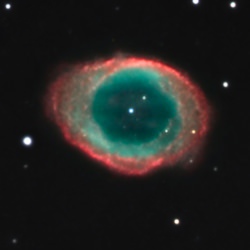
The Ring Nebula by Stefan Heutz. Click to enlarge
When stars similar to our Sun have exhausted their nuclear fuel, they release their outer layer into a beautiful expanding sphere that resembles a planet through a small telescope. The Ring Nebula, pictured here, is one of the most famous examples in the northern sky. But it’s not a sphere. There is another geometry that more accurately explains its beautiful appearance.
Riding high in the northern sky near the bright white star Vega, the Ring Nebula is one of the most favorite deep sky objects targeted visually by backyard stargazers. It can be seen through telescopes with apertures as small as four inches. But larger telescopes can reveal the faint planet sized central star that created this night sky spectacle. The Ring Nebula was discovered about 200 years ago by French astronomer Charles Messier, an avid comet hunter, and made its way into his catalog used to keep track of false comets as item number 57.
Recent imagery by the Hubble Space Telescope has confirmed that the Ring Nebula is not spherical in shape; it is more like a tube that is slightly constricted in the middle so that it resembles a stretched hourglass. By chance alone, Earth is positioned so that we can look almost straight through from one end. Tubular shapes like this are common throughout the universe because thick disks of gas tend to expand outward very slowly leaving the material free to become extended perpendicularly. One of the other more spectacular examples of this shape is exhibited by the Little Dumbbell Nebula. It’s located in the constellation of Perseus and is positioned so that we have a side view.
The diameter of the nebula’s walls is approximately one light year across. The view we see is actually quite ancient because the light reaching our eyes today departed for Earth about 2,000 years ago.
This beautiful image represents one of the best views taken from our planet’s surface. It was produced by German astro-photographer Stefan Heutz from his backyard imaging location though an eleven-inch Schmidt-Cassegrain telescope and a 1.5 mega-pixel camera. The light for this image was gathered on June 7, 2005 and represents 46 minutes of total exposure.
Do you have photos you’d like to share? Post them to the Universe Today astrophotography forum or email them, and we might feature one in Universe Today.
Written by R. Jay GaBany
